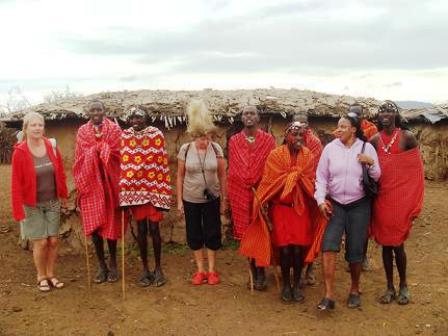Kenya Language
Although the official Kenyan languages are Swahili and English, there are actually a total of 62 languages spoken in the country.
These mainly consist of tribal African languages as well as a minority of Middle-Eastern and Asian languages spoken by descendants of foreign settlers (i.e. Arabic, Hindi, etc).
The African languages come from three different language families - Bantu languages (spoken in the center and southeast), Nilotic languages (in the west), and Cushitic languages (in the northeast).
Kenya Language Meeting and Greeting
 When greeting someone
When greeting someone\• The most common greeting is the handshake.
• When greeting someone with whom you have a personal relationship, the handshake is more prolonged than the one given to a casual acquaintance.
• Close female friends may hug and kiss once on each cheek instead of shaking hands.
• When greeting an elder or someone of higher status, grasp the right wrist with the left hand while shaking hands to demonstrate respect.
• Muslim men/women do not always shake hands with women/men.
• The most common greeting is “Jambo?” (“How are you?”), which is generally said immediately prior to the handshake.
• After the handshake it is the norm to ask questions about the health, their family, business and anything else you know about the person.
• To skip or rush this element in the greeting process is the height of poor manners.
• People are generally addressed by their academic, professional or honorific title followed by their surname.
• Once a personal relationship has developed, you may be able to address a person by their title and first name, first name alone, or nickname. Wait for the Kenyan to determine that your friendship has reached this level of intimacy.
• Women over the age of 21 are often addressed as “Mama” and men over the age of 35 are often addressed as “Mzee”. Children generally refer to adults as Aunt or Uncle, even if there is not a familial relationship.
Kenya Language Communication Style
Direct and frank communication is not the norm in Kenya. Kenyans will always attempt to qualify what they say so that the message is delivered in a sensitive way. This comes down to wanting to protect people’s face and the relationship.
If the relationship is intimate the communication style will become more direct. For newly established and more formal relationships, diplomacy will be of utmost importance.
In their attempt not to cause problems, Kenyans often use metaphors, analogies and stories to make a point. They are uncomfortable with blunt statements. If you are from a culture that prizes directness, you may wish to moderate your delivery style.
It is also up to you to read between the lines and decipher what may really being said. With this in mind, criticism should be delivered in private and given in a circumspect manner. Kenyans may gesture for emphasis when speaking.
Loud voices are generally only used during disagreements in business situations, although in rural areas, louder speaking tones are the norm. Showing anger is considered a sign of mental instability. Kenyans pride themselves on their emotional control and expect the same in others.
Since maintaining honor and dignity are paramount, Kenyans may offer what they believe is the expected response rather than say something that might embarrass the other person. They often go out of their way to keep from doing something that could bring shame to another person.
They expect business colleagues and superiors to inquire about their family before beginning a business discussion.
Kenyan Sign Language
Kenya Language and Kenyan Sign Language is considered the natural language of the deaf in Kenya. The beginnings of the language are linked with the opening of deaf schools in the 1960s.
Kenyan Sign Language has been influenced by a number of different sign languages and sign systems, but the largest influences are probably American Sign Language and Signed English.
This has probably been due to policies enacted by institutions throughout Kenya that train teachers in sign language, and personal and professional exchanges with Americans and American educational institutions.
Kenyan Sign Language is now beginning to gain recognition among administrators and policymakers working with deaf school. The manual alphabet is similar to the American manual alphabet. Kenyan Deaf say an old Kenyan system once existed for the manual alphabet, but it is no longer used or understood.
Teachers in deaf schools are now encouraged to use KSL when teaching general subjects and a form of Signed English when teaching English. Teachers are also supposed to teach their students KSL. Unfortunately, many of the teachers lack proficiency in Kenyan Sign Language.
The Kenyan government has not yet officially recognized KSL as the language of the Deaf. In the draft Constitution that was proposed in 2005, KSL was to be recognized alongside English and Swahili as the languages of Kenyans. (The proposed Constitution was not approved.)
Other Pages of Interest
Kenya Culture | Akamba | British Colonialists | Crafts | Cultural Business Meetings | Cultural Communication | Cultural Eye Contact | Cultural Gestures | Gift Giving | Cultural Law | Cultural Music | Cultural Space | Cultural Time | How to Talk in Kenya |Recent Articles
-
Garam Masala Appetizers ,How to Make Garam Masala,Kenya Cuisines
Sep 21, 14 03:38 PM
Garam Masala Appetizers are originally Indian food but of recent, many Kenyans use it. Therefore, on this site, we will guide you on how to make it easily. -
The Details of the Baruuli-Banyara People and their Culture in Uganda
Sep 03, 14 12:32 AM
The Baruuli-Banyala are a people of Central Uganda who generally live near the Nile River-Lake Kyoga basin. -
Guide to Nubi People and their Culture in Kenya and Uganda
Sep 03, 14 12:24 AM
The Nubians consist of seven non-Arab Muslim tribes which originated in the Nubia region, an area between Aswan in southern










New! Comments
Have your say about what you just read! Leave me a comment in the box below.